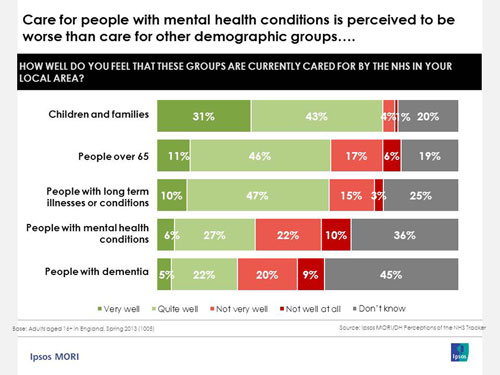Mental health services and spending: what do the public think?
 Since the introduction of the Health and Social Care Act in 2012, NHS England has been legally mandated to deliver parity between physical and mental health services. However, the situation in the UK remains challenging. While mental illness accounts for 23% of the burden of disease in the UK, it receives only 13% of total NHS health expenditure. With pressure on mental health services in the UK continuing to rise, many leading mental health organisations have called for it to be made a priority during the 2015 General Election and beyond.
Since the introduction of the Health and Social Care Act in 2012, NHS England has been legally mandated to deliver parity between physical and mental health services. However, the situation in the UK remains challenging. While mental illness accounts for 23% of the burden of disease in the UK, it receives only 13% of total NHS health expenditure. With pressure on mental health services in the UK continuing to rise, many leading mental health organisations have called for it to be made a priority during the 2015 General Election and beyond.
Indeed, our public perceptions research for the Department of Health, conducted in 2013, indicated that, among the general public, care for people with mental health conditions or dementia was perceived to be worse than the care received by other key patient groups – only 33% felt that people with mental health conditions were well cared for, compared to 74% saying this for children and families and 57% for people over 65. And they were pessimistic about the future; only 20% thought the care provided for people with mental health conditions would get better over the next few years.

In the run up to the election all three key parties have outlined their plans for mental health, should they come to power following May 7th. Nick Clegg was the first to raise the issue in the seven-way leaders’ debate, and the Lib Dems have pledged to increase mental health spending in England by £500 million a year by 2016/17.The Conservatives have also committed to increasing the spending on mental health care, while Labour have pledged to increase the proportion of the mental health budget spent on children, and to introduce waiting time targets for access to talking therapies.
So the burden of mental health conditions is being recognised and prioritised, to varying extents, by the parties. But what levels of support are there for increased spending amongst the general public?
Our most recent research shows that there is a great deal of support – around eight in ten people (78%) say that the proportion of spending on mental health services should be increased, with just 1% saying it should be decreased. Perhaps this is not a surprise; we know generally that the public want to see more funding for the NHS, with 85% thinking the NHS should be protected from any cuts to public spending. So is this not so much about increased funding for mental health services, but just about the two words “spending” and “health”?
To help us understand this, we wanted to test whether presenting people with the actual figure currently spent on mental health services affected their responses. We used a split sample approach and told half our sample that mental health services received 13% of spending, and then asked the same question. We hypothesised that a difference one way or the other would tell us something about the relative importance for the public between mental and physical health services. Would telling them that the current figure was 13% make them more or less likely to think that the proportion should be increased?
In fact, it made no difference whatsoever. Again, almost eight in ten people (77%) supported an increase, and just 2% a decrease.

So, what does this tell us? We might assume that people knew how much was spent on mental health services and so were already factoring this in when giving us their response. This is unlikely. We know from our perils of perception work how difficult the public find putting numbers to anything. For example, we think the British population is much older than it actually is – the average estimate is that 37% of the population are 65+, when it is in fact only 17%.
It’s more likely then that the public are making an emotive judgement that spending on mental health services needs to increase. Given that they generally want more spent on the NHS and they think that care for people with mental health conditions compares unfavourably with other groups, then perhaps it’s no surprise that they think the proportion spent on these services should increase. Presenting them with facts about the current level of spending makes little difference to these gut feelings and therefore, little difference to their response.
These findings are based on a simple question asked about what is in reality a very complex health service. However, it does indicate that the key parties have identified a health issue that resonates with the general public. The challenge is how to make these pledges a reality in the coming years.
- Lara Sarson, Anna Carluccio and Charlotte Simms contributed to this blog post.
- Download the slides (PDF)



